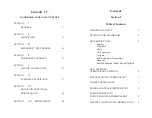
4
1. CHARACTERISTICS
1.1 WHO IS IT DESIGNED FOR?
This wing is designed for cross-country flights and competitions.
Aimed at advanced, experienced pilots and high-level competition pilots.
The optimisation of the profile and the internal structure make the fifth
generation a fast and top performance wing with the smoothest and
most direct handling in its class. The internal structure allows the wing to
reach high speed without compromising on stability. Therefore, it is not
necessary to sacrifice speed in order to gain stability. With this wing, the
pilot will have the feeling of great safety and confidence.
1.2 CERTIFICATION
The PEAK 5 has been submitted for the European EN and LTF
certification. All certification tests were performed at the Swiss testing
house Air Turquoise. All sizes passed the load, shock and flight tests.
The load test proved that the wing can withstand the stipulated 8G.
The shock test proved that the wing can resist 1000 daN of force.
The flight test resulted in the following certification for all sizes:
EN D
LTF D
We recommend that only pilots who are familiar with gliders of this
certification or above fly this paraglider.
Only the aeronautical authorities of respective countries can determine
pilot competence.
We recommend pilots read the flight test report carefully,
especially the comments of the test pilot. The report contains all the
necessary information on how the paraglider reacts during each of the
tested manoeuvres.
It is important to note that different size wings will react differently during
manoeuvres. Even within the same size, at maximum or minimum load,
the behaviour and reactions of the wing may vary
Description of flight characteristics of LTF/EN D paragliders:
Paragliders with demanding and unique flight characteristics with
potentially violent reactions in turbulence and to pilot errors.
Normal flight recovery requires precise pilot intervention.
- Description of the pilot skills required for an EN D wing:
For pilots trained in recovery techniques, who fly very actively, have
significant experience of flying in turbulent conditions and who accept
the consequences of flying with this type of wing.
For further information on the flight test and the corresponding
certification number, please see the final pages of this manual or see
niviuk.com.
1.3 IN-FLIGHT BEHAIVOR
Niviuk developed this wing by adopting very specific goals: to improve
performance, excellent handling; to facilitate more control for the pilot.
To increase performance while maintaining the highest level of
safety. To ensure that the wing transmits the maximum feedback in
an understandable and comfortable way so that the pilot can focus
on piloting and enjoying the flight. And, with smooth handling, take
advantage of all favourable conditions.
In all aspects of flight, the wing is very solid and stable. The glide is
Summary of Contents for PEAK 5
Page 1: ...PEAK 5 User s manual...
Page 21: ...10 3 RISERS PLAN 22...
Page 22: ...10 4 SUSPENSION PLAN 23...
Page 27: ...niviuk com...



































